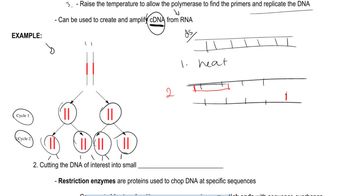Table of contents
- 1. Introduction to Genetics51m
- 2. Mendel's Laws of Inheritance3h 37m
- 3. Extensions to Mendelian Inheritance2h 41m
- 4. Genetic Mapping and Linkage2h 28m
- 5. Genetics of Bacteria and Viruses1h 21m
- 6. Chromosomal Variation1h 48m
- 7. DNA and Chromosome Structure56m
- 8. DNA Replication1h 10m
- 9. Mitosis and Meiosis1h 34m
- 10. Transcription1h 0m
- 11. Translation58m
- 12. Gene Regulation in Prokaryotes1h 19m
- 13. Gene Regulation in Eukaryotes44m
- 14. Genetic Control of Development44m
- 15. Genomes and Genomics1h 50m
- 16. Transposable Elements47m
- 17. Mutation, Repair, and Recombination1h 6m
- 18. Molecular Genetic Tools19m
- 19. Cancer Genetics29m
- 20. Quantitative Genetics1h 26m
- 21. Population Genetics50m
- 22. Evolutionary Genetics29m
18. Molecular Genetic Tools
Genetic Cloning
Problem 1c
Textbook Question
In this chapter we focused on how specific DNA sequences can be copied, identified, characterized, and sequenced. At the same time, we found many opportunities to consider the methods and reasoning underlying these techniques. From the explanations given in the chapter, what answers would you propose to the following fundamental questions?
How has DNA-sequencing technology evolved in response to the emerging needs of genome scientists?
 Verified step by step guidance
Verified step by step guidance1
<span>1. Begin by discussing the early methods of DNA sequencing, such as the Sanger sequencing method, which was the first widely used technique for determining the nucleotide sequence of DNA.</span>
<span>2. Explain the limitations of early sequencing methods, such as being time-consuming and costly, which led to the need for more efficient technologies.</span>
<span>3. Describe the development of next-generation sequencing (NGS) technologies, which allowed for massively parallel sequencing, significantly increasing the speed and reducing the cost of sequencing.</span>
<span>4. Highlight the impact of NGS on genome science, enabling large-scale projects like the Human Genome Project and personalized medicine initiatives.</span>
<span>5. Discuss the latest advancements, such as third-generation sequencing technologies, which offer even longer read lengths and faster sequencing times, further meeting the needs of genome scientists.</span>
Recommended similar problem, with video answer:
 Verified Solution
Verified SolutionThis video solution was recommended by our tutors as helpful for the problem above
Video duration:
1mPlay a video:
Was this helpful?
Key Concepts
Here are the essential concepts you must grasp in order to answer the question correctly.
DNA Sequencing Technologies
DNA sequencing technologies refer to the methods used to determine the precise order of nucleotides within a DNA molecule. Over the years, these technologies have evolved from Sanger sequencing, which is labor-intensive and time-consuming, to next-generation sequencing (NGS) methods that allow for rapid, high-throughput sequencing of entire genomes. This evolution has significantly enhanced the ability of scientists to analyze genetic information efficiently.
Recommended video:
Guided course

Sequencing Overview
Genome Science Needs
Genome science encompasses the study of genomes, including their structure, function, evolution, and mapping. As the field has advanced, the need for more efficient, cost-effective, and accurate sequencing methods has grown, driven by applications in personalized medicine, evolutionary biology, and genetic research. Understanding these needs helps explain the technological advancements in sequencing methods.
Recommended video:
Guided course

Genomics Overview
Emerging Technologies in Genomics
Emerging technologies in genomics include innovations such as CRISPR for gene editing, single-cell sequencing, and bioinformatics tools that analyze large datasets. These technologies have emerged in response to the increasing complexity of genomic data and the demand for precise manipulation and understanding of genetic material. Their development has been crucial for addressing the challenges faced by genome scientists in their research.
Recommended video:
Guided course

Genomics Overview

 7:43m
7:43mWatch next
Master Genetic Cloning with a bite sized video explanation from Kylia Goodner
Start learningRelated Videos
Related Practice


